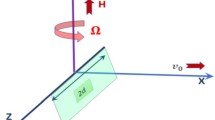Abstract
Based on a line-integral expression for the energy release rate in terms of crack tip fields, which is valid for general material response, a (area/volume) domain integral expression for the energetic force in a thermally stressed body is derived. The general three-dimensional finite domain integral expression and the two-dimensional and axisymmetric specializations for the energy release rate are given. The domain expression is naturally compatible with the finite element formulation of the field equations. As such it is ideally suited for efficient and accurate calculation of the pointwise values of the energy release rate along a three-dimensional crack front. The finite element implementation of the domain integral corresponds to the virtual crack extension technique. Procedures for calculating the energy release rate using the numerically determined field solutions are discussed. For illustrative purposes several numerical examples are presented.
Résumé
En sa basant sur une intégrale simple exprimant le taux de relaxation d'énergie afférant aux champs de contrainte à l'extrémité d'une fissure, expression applicable à la réponse d'un matériau quelconque, on a déduit une intégrale de domaine (superficielle ou volumique) décrivant l'énergie dans un corps soumis à contraintes thermiques.
On fournit l'intégrale générale relative à un domaine fini tridimensionnel et á des cas particuliers bidimensionnels et axisymétriques, exprimant le taux de relaxation d'énergie. L'intégrale de domaine est naturellement compatible avec une formulation par éléments finis des équations de champ. Comme telle, elle convient idéalement pour un calcul facile et précis des valeurs ponctuelles du taux de relaxation de l'énergie le long du front d'une fissure tridimensionnelle. L'implantation d'éléments finis dans l'intégrale de domaine correspond à une technique d'extension virtuelle de la fissure. On discute des procédures de calculs du taux de relaxation de l'énergie, qui utilisent les solutions relatives au champ déterminées par voie numérique. A titre d'illustration, on présente plusieurs exemples numériques.
Similar content being viewed by others
References
J.W. Hutchinson, Journal of Applied Mechanics 50 (1983) 1042–1051
J.R. Rice, R.M. McMeeking, D.M. Parks and E.P. Sorensen, Computer Methods in Applied Mechanics and Engineering 17/18 (1979) 411–442
D.M. Parks, International Journal of Fracture 10 (1974) RCR 487–502
D.M. Parks, Computer Methods in Applied Mechanics and Engineering 12 (1977) 353–364
T.K. Hellen, International Journal of Numerical Methods in Engineering 9 (1975) 187–207
H.G. de Lorenzi, International Journal of Fracture 19 (1982) 183–193
F.Z. Li, C.F. Shih and A. Needleman, Engineering Fracture Mechanics 21 (1985) 405–421
C. Atkinson and J.D. Eshelby, International Journal of Fracture Mechanics 4 (1968) 3–8
B.V. Kostrov and L.V. Nikitin, Archiwum Mechaniki Stosowanej 22 (1970) 749–775
L.B. Freund, Journal of Elasticity 2 (1972) 341–349
T. Nakamura, C.F. Shih and L.B. Freund, International Journal of Fracture 27 (1985) 229–243
O.S. Nguyen, in Three-Dimensional Constitutive Relations and Ductile Fracture, edited by S. Nemat-Nasser, North-Holland Publishing Co., Amsterdam (1981) 315–330
J.R. Rice, in Fracture: An Advanced Treatise, edited by H. Liebowitz, Vol. 2, Academic Press (1968) 191–311
J.D. Eshelby, in Inelastic Behavior of Solids, edited by M.F. Kanninen, McGraw-Hill, New York (1970) 77–114
B. Budiansky and J.R. Rice, Journal of Applied Mechanics 40 (1973) 201–203
W.K. Wilson and I.-W. Yu, International Journal of Fracture 15 (1979) 377–387
S. Aoki, K. Kishimoto and M. Sakata, Engineering Fracture Mechanics 16 (1982) 405–413
H.G. deLorenzi, “Energy Release Rate Calculations by the Finite Element Method,” General Electric Company TIS Report 82 CRD205 (1982)
R.S. Barsoum, International Journal for Numerical Methods in Engineering 11 (1977) 85–98
M.A. Hussain, C.F. Shih, and M.D. German, “Lagrangian Elements as Singularity Elements in Crack Analysis,” General Electric Company, Technical Information Series Report No. 80CRD291 (December 1980)
D.S. Malkus and T.J.R. Hughes, Computer Methods in Applied Mechanics and Engineering 15 (1978) 63–81
C.F. Shih and A. Needleman, Journal of Applied Mechanics 51 (1984) 48–56
O.C. Zienkiewicz, The Finite Element Method, McGraw-Hill, London, England (1977)
C.F. Shih, H.G. deLorenzi and W.R. Andrews, in Elastic-Plastic Fracture, ASTM STP 668, edited by J.D. Landes et al., American Society for Testing and Materials (1979) 65–120
B.R. Bass, R.H. Bryan, J.W. Bryson and J.G. Merkle, Journal of Pressure Vessel Technology 104 (1982) 308–316.
B.R. Bass and J.W. Bryson, International Journal of Fracture 22 (1983) R3-R7.
H.G. deLorenzi and C.F. Shih, International Journal of Fracture 21 (1983) 195–220.
Author information
Authors and Affiliations
Rights and permissions
About this article
Cite this article
Shih, C.F., Moran, B. & Nakamura, T. Energy release rate along a three-dimensional crack front in a thermally stressed body. Int J Fract 30, 79–102 (1986). https://doi.org/10.1007/BF00034019
Received:
Revised:
Issue Date:
DOI: https://doi.org/10.1007/BF00034019




